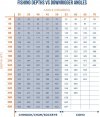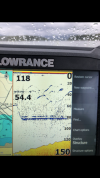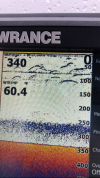You are using an out of date browser. It may not display this or other websites correctly.
You should upgrade or use an alternative browser.
You should upgrade or use an alternative browser.
Rigger angle blow back chart
- Thread starter kingblazer84
- Start date
Rain City
Crew Member
That's all kinds of wrong.saw this on island fisherman thought it’s kinda interesting now all these numbers are based off of 15 and 18lb lead
the blue is the number you need to be at in order to hit the depth in orange
kingblazer84
Crew Member
Lol wait till you find the article and read the equation he used with cosign and other mathematical equationsThat's all kinds of wrong.
ab1752
Crew Member
Lol wait till you find the article and read the equation he used with cosign and other mathematical equations
Again with the maths, geez
Last edited:
Pineapple Express
Well-Known Member
Uhhhhh, what downrigger line? Braid? Wire? What diameter?
Charlie415
Crew Member
Exactly! See fish on sounder lower lines until you get a hit. That's your depth. Too many variables to worry about. It will give you an idea how deep you are but if you have the right transducer it is right there on your screen.Uhhhhh, what downrigger line? Braid? Wire? What diameter?
Doubleheader
Well-Known Member
Rigger cable thickness is a huge factor. Had to run my spare rigger yesterday with the junk Scotty braid, hung back way more than the power pro on the other side.
Doubleheader
Well-Known Member
Never heard that before, but I can’t see down 250’ either lol. I know angle gets me more fish than watching SOG…Cable angle isn't constant. You can have 60* at the surface and almost vertical at the ball. I usually aim for about 45*. I was fishing 220' last night and hitting bottom with about 250 with braid and 18 lbs balls.
kingblazer84
Crew Member

Downrigger Fishing Angles for Salmon - Island Fisherman Magazine
Downrigger angle and depth are both important to get those trophy salmon. Here are two tricks of the trade that can make you fish more effectively for salmon when you are out on the water.
heres the article lol
Brian Reiber
Well-Known Member
Trigonometry is cool and very useful in some things. But like most already stated, there is just too many variables with downriggers. We pay attention to the action of the gear when we are putting it down, and the angle of the dangle (downrigger). If we are fishing deep we will run down and smack bottom which gives you an idea of the relationship between rigger counter and actual depth. If fishing shallow we hope the counter is close. To be honest (and I'm sure many here will disagree) if a fish is so picky that it won't move up or down 10' or 15' feet to smack my lure I figure it probably wasn't going to hit it if I put it right in front of it's face either.
Rain City
Crew Member
It really doesn't matter what depth I'm at. The fish come to me.Trigonometry is cool and very useful in some things. But like most already stated, there is just too many variables with downriggers. We pay attention to the action of the gear when we are putting it down, and the angle of the dangle (downrigger). If we are fishing deep we will run down and smack bottom which gives you an idea of the relationship between rigger counter and actual depth. If fishing shallow we hope the counter is close. To be honest (and I'm sure many here will disagree) if a fish is so picky that it won't move up or down 10' or 15' feet to smack my lure I figure it probably wasn't going to hit it if I put it right in front of it's face either.
Corey_lax
Crew Member
Doubleheader
Well-Known Member
Bingo…I can see my downrigger balls on the screen so I know where they are at. This isn’t the best photo but ones at 70 something and ones at 80 something
Northdogboy
Active Member
The trig. Is not wrong its just getting that angel right that makes the big difference.
I'm using a kayak and with my pedal drive I don't want to push over the 5lb ball I got so iv got to fight out blow back.
I'm using a kayak and with my pedal drive I don't want to push over the 5lb ball I got so iv got to fight out blow back.
Baxter
Well-Known Member
Rigger cable thickness is a huge factor. Had to run my spare rigger yesterday with the junk Scotty braid, hung back way more than the power pro on the other side.
I have newer Scotty's with their stock braid. Have never tried anything else. Does the PowerPro really make that much of a difference? Never crossed my mind that it would matter much - perhaps when I am due to replace my line (OR when the wife isn't looking) I will replace it, if the general consensus is that it matters...
Foxsea
Well-Known Member
Unfortunately all wrong, as Rain City said. The issue is that he assumes the angle at the surface is constant - it's not so trig is useless. Apart from the other influences mentioned, the arc made by the line is actually parabolic, with a steeper angle at the surface, curving gradually to almost vertical near the ball. The influences will cause the curve to slightly vary in shape. Calculations can be done but as mentioned, why bother. There are easier ways.
Baxter
Well-Known Member
I agree. Just to confirm, I charted it and confirmed that this assumes the angle is constant, the chart was linear which would be incorrect. Needs to account for the curve. Sure math with some physics can solve this, but as you note, there are SO many other factors that would change how deep you really go (currents, speed, line thickness & type, cannonball shape and more).Unfortunately all wrong, as Rain City said. The issue is that he assumes the angle at the surface is constant - it's not so trig is useless. Apart from the other influences mentioned, the arc made by the line is actually parabolic, with a steeper angle at the surface, curving gradually to almost vertical near the ball. The influences will cause the curve to slightly vary in shape. Calculations can be done but as mentioned, why bother. There are easier ways.
The math would be complicated when you factor in all variables, but perhaps someone at NASA can build an app for us. I am pretty darn good at Math, but this goes well beyond my expertise!
Just drop the rigger till you bounce off bottom, read your numbers, and you'll know for sure
Last edited:
Similar threads
- Replies
- 0
- Views
- 620



